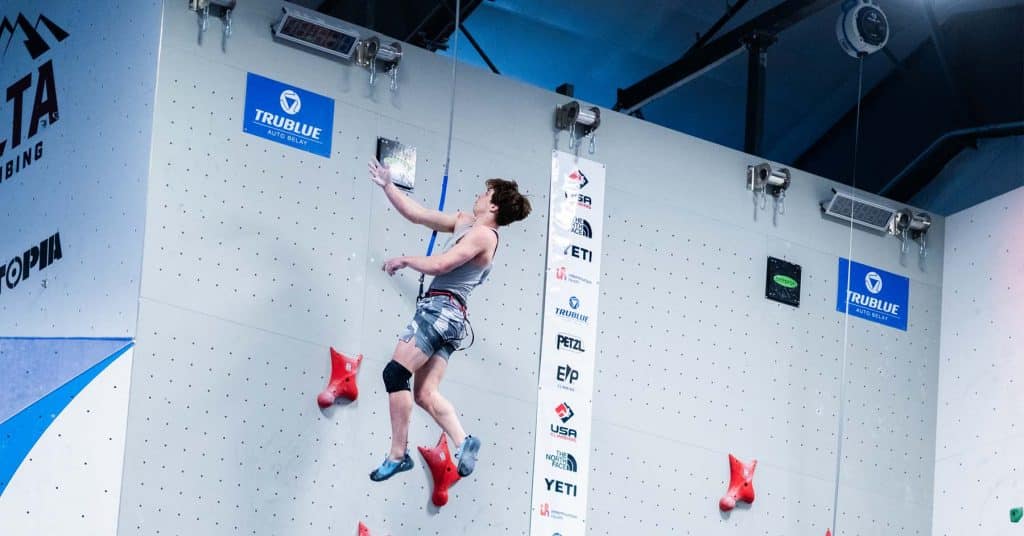Key Takeaways:
- Speed Climbing: Speed climbing blends the physical demands of climbing with the pulse-pounding excitement of racing head-to-head against another climber, highlighting the evolving landscape of international sports.
- Olympic Impact: The sport's inclusion in the Olympics has spurred significant interest and investment in climbing, boosting global participation and infrastructure development.
- Technological Advancements: Technological advancements, such as magnetic braking systems, have revolutionized climbing gear, enhancing performance and safety for athletes in high-intensity events like speed climbing.
In the pantheon of Olympic sports, tradition meets modernity, including speed climbing, which has sparked a wave of enthusiasm and intrigue globally. This thrilling discipline, now showcased on the world’s most prestigious athletic stage, blends the physical demands of climbing with the pulse-pounding excitement of a race against the clock. Speed climbing was introduced in the Olympics during the 2020 Games; however, 2024 will be the first year speed climbing is a standalone event instead of one-third of a combined sport climbing format. As the latest standalone event addition to the Olympic games, speed climbing offers a fresh dynamic to the competition and highlights the evolving landscape of international sports.
At Head Rush Technologies, where innovation meets safety and exhilaration, we recognize the importance of such milestones in adventure sports.
This article aims to explore the compelling journey of speed climbing from niche pursuit to the Olympic spotlight, illustrating how this sport has scaled new heights and captured the imagination of millions. Join us as we get into the origins and ascent of speed climbing as a premier event at the Olympic Games.
The New Olympic Sport Defined
Speed climbing, introduced in the Olympics, is a competitive format in which climbers race against each other and the clock to ascend a fixed route on a 15-meter-high wall. In this adrenaline-pumping event, two climbers are connected to a specialty auto belay device and sprint up identical routes set next to each other. The objective is clear and simple: to reach the top before the other climber. The routes are standardized internationally, meaning they are identical in terms of holds and arrangement, ensuring fairness and consistency across competitions.
This event is distinct from other climbing disciplines, such as bouldering and lead climbing, where the focus may vary between technical prowess and physical endurance. Speed climbing, by contrast, emphasizes explosive power, swift decision-making, and flawless execution under pressure. Each athlete uses quick and dynamic movements to gain momentum, navigate the wall, and ultimately slap the top pad to stop the timer.
The walls used in Olympic speed climbing are equipped with an auto belay system that ensures the climber's safety while allowing for rapid descent and quick turnaround times for continuous competition. Head Rush Technologies’ TRUBLUE Auto Belays are the only auto belays with magnetic braking. They are designed to provide a safe, smooth experience for speed climbers and adventure enthusiasts engaging in similar high-intensity activities.
Historical Roots Of Competitive Climbing
The first official climbing competitions appeared in the 1980s, with the Sportroccia competition held in Italy in 1985 often credited as the first true climbing competition. This event marked a significant turning point, showcasing climbing not just as a recreational activity but as a competitive sport. It involved climbers attempting to ascend routes of varying difficulty within a set time, setting the stage for more structured events.
In the years that followed, climbing competitions split into different disciplines, among which speed climbing gained significant attention in the run-up to the 2020 Olympic Games. Speed climbing tests climbers’ ability to ascend a route in the shortest time possible, adding an exhilarating element of racing against the clock that appeals to spectators and participants alike. This format thrives indoors, where standardized climbing routes ensure fair competition.
Throughout the 1990s and early 2000s, the climbing community saw a surge in competition organization, with the establishment of bodies such as the International Federation of Sport Climbing (IFSC) in 2007. The IFSC played a pivotal role in promoting climbing as a global sport and was instrumental in lobbying for its inclusion in the Olympic Games.
As competitive climbing grew in popularity, the stage was set for its historic Olympic debut, with speed climbing presented as one of the thrilling, spectator-friendly formats. This inclusion marked the acknowledgment of climbing as a sport that demands physical excellence and mental fortitude and a captivating competitive spectacle.
The Advantages Of Speed Climbing As An Olympic Event
The inclusion of speed climbing in the Olympic Games offers myriad benefits that stretch from local climbing walls to the global sporting community. Here are some key ways in which Olympic recognition is transforming speed climbing:
Global Exposure And Increased Participation
With its inclusion in the Olympics, speed climbing enjoys unprecedented global exposure. It captivatingly captures audiences worldwide and inspires a new generation of climbers. This visibility promotes the sport and dramatically increases participation rates, expanding the climbing community and fostering a universal culture around climbing.
Recognition of Climbing As A High-Skill Sport
Speed climbing demonstrates the intricate blend of physical and mental skills required, such as strength, agility, and tactical thinking. Olympic athletes represent the pinnacle of these capabilities, showcasing climbing as a deeply challenging sport. This recognition helps elevate climbing's status within the sports community and underscores the rigorous training and dedication required of elite climbers.

Infrastructure Development And Talent Cultivation
The growth in popularity of speed climbing has motivated countries to develop better climbing facilities. These improvements provide climbers with higher-quality training environments and enable more people to participate in climbing. Enhanced infrastructure acts as a foundation for cultivating talent, giving climbers from diverse regions a chance to train at an elite level and compete on the world stage.
Economic And Professional Advantages
Olympic inclusion brings substantial economic benefits to the sport of climbing. Increased interest leads to greater investment from sponsors and a boost in funding for climbing facilities and competitions. This professionalization of the sport ensures better-organized events, more sophisticated training programs, and improved safety protocols, which collectively elevate the overall standard of the sport.
Speed climbing is also popular in regions not traditionally known for rock climbing. Speed climbing teams from countries such as Indonesia, China, and Iran have flourished in the sport, introducing climbing to a broader international audience in places where outdoor climbing access is not readily available.
Speed Climbing: The Controversy And Debate
As the profile of speed climbing has risen, so has the controversy surrounding its place within the broader climbing community and its inclusion in the Olympics. Traditionalists argue that speed climbing—focused on rapid ascent on a standardized route—deviates significantly from the sport's roots, emphasizing technique, problem-solving, and a connection with the rock. Critics say it transforms climbing into something more akin to a sprint, losing its nuanced, contemplative nature in the process.
Moreover, the decision to bundle speed climbing with lead and bouldering into a single combined event for the Tokyo Olympics drew further ire. Many athletes and fans felt that this format diluted the recognition of skills, as climbers typically specialize in one format and might not excel in the others. The format required competitors to participate in all three disciplines, which some argued could favor those more versatile at the expense of those who excel in a single discipline.
This controversy continues to evolve as the international climbing community and the Olympic organizers discuss and implement feedback from athletes, coaches, and fans. While some purists remain skeptical, others embrace the evolution of climbing as a competitive sport, viewing it as an opportunity for the discipline to grow and reach new audiences and heights.
Technological Advancements In Climbing Gear: A Closer Look
Magnetic Braking Systems
Integrating magnetic braking technology represents a significant leap forward in climbing gear designed for speed climbing. Developed to enhance safety and performance, these systems use magnetic fields to create resistance, eliminating the need for physical friction caused by conventional brake pads. This results in less wear and tear, higher durability, and more reliable operation during each climb. Magnetic brakes are especially useful in speed-climbing competitions, where split-second decisions and dynamic movements can significantly impact performance.
Lightweight And Enhanced Harness Designs
Today's harnesses are lighter and designed to be more comfortable, ensuring that climbers can move more freely without compromising safety. Innovations have included using new materials and design techniques, such as laser-cut fabrics and strategically placed padding, which provide optimal support and flexibility.

TRUBLUE: Redefining Auto Belay
One of Head Rush's standout products is the TRUBLUE Auto Belay. Utilizing magnetic braking technology, TRUBLUE offers a consistent descent, seamlessly accommodating climbers of different weights. This makes it an ideal solution for gyms and educational institutions looking to provide a safe, reliable climbing experience. TRUBLUE’s simplicity in setup and minimal maintenance requirements further enhance its appeal, ensuring gyms can provide uninterrupted service to climbers of all skill levels.
Advanced Carabiners
Reliable clipping is crucial in competitive speed climbing. The latest advancements in carabiner technology have made them safer and easier to operate. Features such as ergonomic shapes, lighter materials, and enhanced locking mechanisms, such as the automated triple-locking system of Head Rush Technologies’ TRU-Lock Aluminum Carabiner, enable climbers to save time and effort during climbs. These improvements enhance performance and add an extra layer of safety, as climbers can secure themselves more reliably, even under the pressure of competition.
Final Thoughts
As the spectacle of Olympic speed climbing continues to captivate audiences worldwide, it's clear that this event is more than just a passing trend. It embodies the evolution of climbing as a sport and highlights the incredible athleticism and strategy involved in racing against the clock on a vertical course. For enthusiasts and newcomers alike, including speed climbing in the Olympics is a thrilling showcase of human agility and determination.
At Head Rush Technologies, we are proud to support this dynamic sport through our state-of-the-art equipment to ensure safety and enhance performance for climbers at all levels. As the world of adventure sports continues to grow, we remain committed to empowering epic adventures and pushing the boundaries of what is possible within the realm of climbing and beyond.
Read also:
- Pro Tips for Climbing Ridiculously Fast
- Get to Know Sam Watson: Speed Climbing World Record Holder
- Tips for Hosting a Successful Speed Climbing Competition
Frequently Asked Questions On Speed Climbing At The Olympics
What is speed climbing?
Speed climbing is a discipline in which two competitors scale a fixed route on a 15-meter high wall side by side in the fastest time possible. It is one of the three climbing disciplines included in the Olympic Games, alongside lead climbing and bouldering.
How did speed climbing become an Olympic event?
Speed climbing was introduced into the Olympics in 2020 as part of an effort to include more urban and youth-oriented sports. Its inclusion aimed to broaden the appeal of the Olympics and showcase the athleticism and skill involved in competitive climbing.
What are the rules of speed climbing?
In speed climbing, athletes must climb a standardized route on a 15-meter wall as quickly as possible using a specially calibrated auto belay device for safety. Speed auto belays are designed to take in slack at a faster rate than standard auto belays, allowing the devices to keep pace with even the fastest climbers in the world. False starts and falls result in disqualification.
How high is the speed climbing wall at the Olympics?
The speed climbing wall used in the Olympics is exactly 15 meters (about 49 feet) tall, and the wall angle is standardized at a 5-degree overhang. This ensures consistency across international competitions.
What equipment is used in Olympic speed climbing?
The primary equipment used in Olympic speed climbing includes climbing shoes, a climbing harness,, and a specially engineered automatic belay system, which attaches to the climber’s harness via a triple-locking carabiner. The route is equipped with standardized holds and a precision timing system.
Who are the notable competitors in Olympic speed climbing?
Notable speed climbers often come from a broad range of international backgrounds. Competitors like Vaddriq Leonardo from Indonesia and Aleksandra Miroslaw from Poland have previously set world records and won championships in speed climbing. Samuel Watson from the United States is the current world record holder in men’s speed climbing.
How do climbers train for speed climbing?
Climbers train for speed climbing by focusing on explosive power, agility, and technique. Regular practices include timed drills on the speed wall, strength training, coordination exercises, and mental conditioning.
What is the world record for Olympic speed climbing?
As of the last update, the men's world record for speed climbing was 4.798 seconds, set by Samuel Watson from the United States in 2024. The women's record is 6.24 seconds, achieved by Aleksandra Miroslaw of Poland in 2023.
How is the winner of the speed climbing competition determined?
Advancing through the qualification round of a speed climbing competition is based on which climbers clock the fastest times. Qualification consists of two attempts. Athletes qualify for the final rounds based on their fastest result out of the two.
The final rounds are determined by head-to-hand competitions, in which the winner of each race moves on to the next round. This means that the climber who has the fastest time does not necessarily win the competition. First place is awarded to the climber who wins each race, advancing through the bracket until there are no more challengers.
How does speed-climbing scoring work?
In the 2020 Olympic format, speed climbing was part of a combined event that included bouldering and lead climbing. Each climber's placement in each discipline was multiplied together, and the climber with the lowest score at the end of all three disciplines won.
At the 2024 Games, speed climbing will make its Olympic debut as a standalone event.



